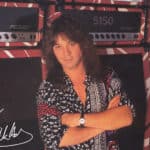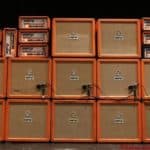Most guitar players gravitate toward tube amps and think of solid-state amps as inferior.
But for jazz guitarists, it is more common to use solid-state rigs, and amps that are designed specifically for jazz almost always use this technology.
Most jazz guitarists want to let their fingers do the talking. So they look for amps with the cleanest output that they can find: a blank canvas or tabula rasa. Since tube amps have a tendency to color the sound a little because of their design, many jazz players opt for solid-state amps.
I think it is best to concentrate mainly on jazz guitarists who are the primary focus of the music: the frontman.
Specifically, guitar jazz that is mostly instrumental and played by famous artists such as Joe Pass, Pat Martino, and Wes Montgomery.
What is the difference between a solid-state and a tube amp?
Tubes/valves were used for many things in the past including televisions, stereos, radios, etc. Tube technology has mostly disappeared except for music amplifiers and audiophile stereos.
The inside of a tube is a vacuum that allows electrons to move through the “air”.
In guitar amps, the signal from the guitar pushes electrons to different components inside the tube, which amplifies the signal. It’s a pretty crazy and complicated technology, to be honest.
Solid-state amps use transistors (often as part of an integrated circuit chip) to amplify a signal with the same basic idea as a tube but in a much simpler and more efficient design.
Tube amps often produce a warmer tone with more harmonics whereas solid-state amps output a more “faithful” tone.
Pros of solid-state amps for jazz
Playing jazz guitar is no small undertaking.
The touch, techniques, and theory take a lot of time to develop and I think that jazz guitarists want the amplifier’s output to accurately reflect their playing instead of “coloring” it as a tube amp might do.
Putting ketchup on an expensive steak is a great analogy to think about (even if the ketchup is super gourmet).
Jazz guitar amps also tend to have a very high wattage and this can be done in a smaller package with solid-state technology.
This makes life easier for gigging musicians since these amps are usually smaller and lighter without sacrificing power.
Even better, they aren’t nearly as fragile as tube amps so they are convenient to transport.
Solid-state amps such as the Roland Jazz Chorus 120 (which doesn’t quite fit that smaller and lighter category) are famous for taking pedals very well so they can be flexible too.
Cons of solid-state amps for jazz
Of course, not every jazz guitarist wants to sound the same and some may appreciate the warmth and even the breakup of a tube amp.
Another drawback to solid-state amps to consider is longevity; famous tube amps tend to have (aftermarket) parts available for them in case repair is needed but you may not be as lucky with a solid-state amp.
A faulty transformer especially can be the end of the road if replacements are not available.
Pros of tube amps for jazz
The Fender Twin Reverb with its famous clean tone and 80 watts is quite a popular amp for jazz too.
The high wattage is important because a jazz player wants lots of “headroom”, which is the range of volume before the tubes become saturated and begin to produce an overdrive/distortion tone.
Famous jazz player George Benson even has a signature Hot Rod Deluxe at 40 watts so it isn’t unheard of to find a jazz guitarist who digs the warm tones of tube amps.
But I don’t think you are going to catch someone playing jazz on a low-watt tube amp like a Fender Champ.
Also, remember that solid-state amps of the past weren’t as good as the ones available today, so in the 1960s, tube amps were probably the only game in town.
The Polytone company began producing a line of Mini-Brute solid-state amps in I think the late 1970s (information about the Polytone company is almost impossible to find) and they became a top choice for jazz guitarists.
Cons of tube amps for jazz
Vacuum tube technology is outdated in most applications. Tube amps for guitar are still popular but they are very expensive to buy and maintain, especially high-watt amps with many power tubes.
Replacing the tubes and having a technician bias the amp for the new tubes will easily cost over $100. Add to that they are usually heavy and more fragile to transport and you may wonder why people still use them.
Why do a lot of jazz players choose solid-state amps?
Of course, many genres of music benefit from the harmonics and saturated overdrive tone of tubes but since this usually doesn’t apply in jazz, there is no reason to put up with the extra headaches associated with them.
And today’s solid-state amps can provide a lot of power and excellent clean tones to accurately amplify the nuances of the player’s style.
Jazz tends to be played on expensive archtop, hollow-body guitars so players want you to hear the sound of the guitar more than the overtones of the amp.
Richie Zellon of The Jazz Guitar Channel on Youtube has a great video covering his choices for the top 5 amps for jazz.
If you haven’t watched the video yet, I will have to spoil it for you a little: 4 of the 5 amps recommended for jazz guitarists use solid-state technology.
So if you are thinking of getting into jazz guitar, it is clear which way the industry is headed.
Which kind of amp should you get?
So if you just want to dabble in jazz but you also play other styles that benefit from tube tone then you can definitely play with a tube amp provided it has enough wattage to provide plenty of clean headroom.
A Fender Twin Reverb, Super Reverb, Blues Jr., or Hot Rod Deluxe should be suitable since most people believe that Fender has the best clean tube amp tones.
Jazz has also evolved with styles such as fusion jazz, which is influenced by rock and funk music.
A traditional jazz quartet may have a guitar, percussion, double bass, and piano but with fusion jazz or other derivations, the guitar player is competing with electric bass, synthesizers, and more, so the guitar tone doesn’t need to be quite so pure and may benefit from the overdrive created by tube saturation.
Now if you want to stick to the old-fashioned jazz guitar style there are plenty of options available to check out.
Wes Montgomery played Fender tube amps but Pat Martino and Joe Pass usually used solid-state amps such as the Polytone Mini-Brute I/II, Roland Jazz Chorus 120, and Acoustic Image Clarus 2Ri.
Polytone amps are difficult to find in good condition anymore but a company called Henriksen makes jazz amps in the same style that can be purchased new.
Roland still makes the Jazz Chorus series in 30, 40, and 120-watt versions and there are other great jazz amps from smaller companies like Acoustic Image, DV Mark, and Quilter Labs.
Jazz guitar isn’t very mainstream, meaning a lot of these amps aren’t available from major retailers like Sweetwater or Guitar Center so you may have to get them directly from the manufacturers.
But if you have the dedication to learn to play jazz I think it’s safe to say that you don’t mind a little extra work.

Hello there, my name is Ramiro and I’ve been playing guitar for almost 20 years. I’m obsessed with everything gear-related and I thought it might be worth sharing it. From guitars, pedals, amps, and synths to studio gear and production tips, I hope you find what I post here useful, and I’ll try my best to keep it entertaining also.





